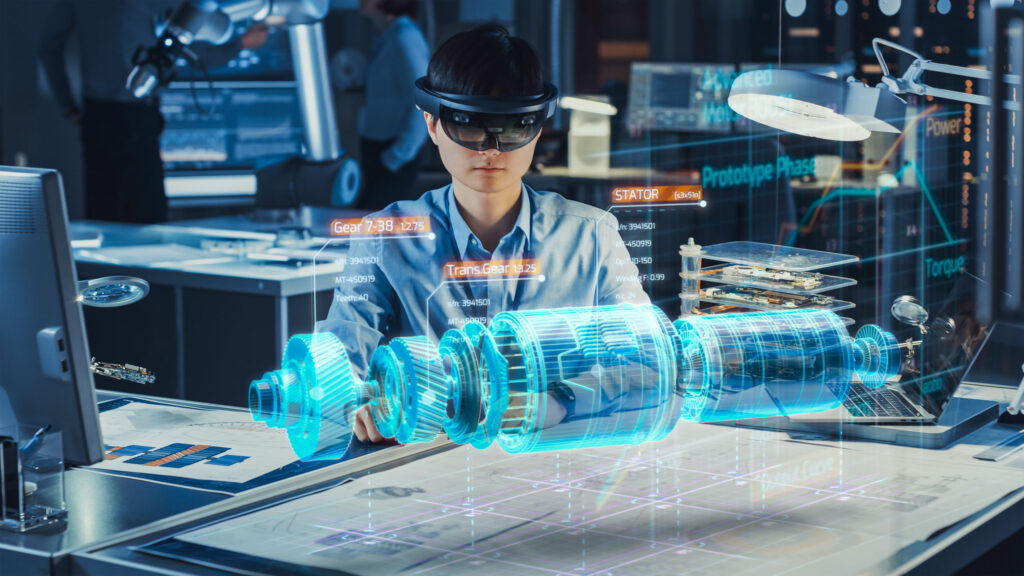In the past year, virtual reality and augmented reality made significant impressions around the world. As a result of this, not only have smartphone users been attracted to AR VR apps, but established and emerging brands have also taken notice, increasing investment in AR VR app development.
The journey had only just begun.
Business has undergone a significant transformation as a result of technology in recent years. Businesspersons who wish to get a larger share of the forecasted market size of USD $1,274.4 billion by 2030 must consult experts and enter this domain to get a bigger slice of the AR VR technology trends in the coming years.
These emerging technologies are expected to have a significant impact on how we interact with others and lead us closer to achieving the digitally augmented space.
Some of the future AR VR solutions are here:
1. Introducing Artificial Intelligence to AR/VR

Augmented reality, virtual reality, and artificial intelligence have entered the business world a long time ago and have proven their potential individually.
As AR VR developers and development company executives,VR AR developers will be excited to discuss the possibilities for collaboration in the future. Computers and other devices will be able to visualize and understand things better by using advanced AI methodologies and machine learning algorithms.
This will further enhance the capabilities of image recognition and create highly interactive workspaces.
2. Augmented reality avatars are on the rise

The popularity of virtual celebrities like Kizuna AI from Activ8 and Lil Miquela from Brud has skyrocketed in the past few years. Consumers have become captivated by these characters, making them their virtual influencers. This will increase the market opportunities for their products in the upcoming years.
Marketing and business leaders should incorporate these avatars not only for attracting users, but also for helping them navigate inside and outside of physical stores as well.
3. The power of AR to gear up vehicles

The use of autonomous vehicles is growing worldwide. Autonomous cars are attracting people’s curiosity. But, what’s fascinating is how Augmented Reality will be integrated into the vehicles of the future.
The automotive industry will have plenty of opportunities to rethink how people move and travel in the coming years by embracing next-generation technologies like voice assistants, in-car augmented reality, and more.
4. The AR/VR evolution will be accelerated by 5G

This is a significant change in the way we perceive AR/VR, as mentioned in our blog on how 5G impacts mobile apps.
Thanks to 5G’s super-fast mobile network, consumers will receive an enhanced virtual experience through faster data transfers, faster cloud processing, and the formation of virtual images.
In addition, the technology will help to get the best out of cheaper headsets and devices, even in environments with low bandwidth and low powered.
5. Inaugural event for Web AR

Mobile devices were the only devices that could experience AR until yesterday. In order to access the augmented world, one needs to download and install a mobile application. However, WebAR now exists.
This site is meant to facilitate user interaction with augmented reality on the web, as depicted from its name. In this way, they can experience AR regardless of the device they are using Google Chrome, Mozilla Firefox, or another such browser that supports AR, lowering barriers to its usage and enhancing the overall experience.
6. Augmented/virtual reality displays: advancements

AR and VR display advancements will also continue to grow in importance.
Displays on the AR/VR headsets this year will be magnified, ensuring that the enormous amount of high-power content displays clearly without being blurry.
7. Augmented and virtual reality for remote assistance

Remote assistance and collaboration will become easier with AR and VR trends.
With this technology, technicians can view real-time situations on site directly from their mobile phones or laptops. All files (images, videos, and PDFs) can be viewed, discussed, and sent to remote locations with comments/notes that will remain locked on the shared scene.
8. Medical device use of XR in healthcare
As AR, MR, and VR each provide different purposes in healthcare, they are revolutionizing this industry.

In addition, healthcare professionals can access these three technologies from the same application by being able to swipe between them. As a result, professionals will be able to enjoy the advantages of both productivity and efficiency.
XR platforms will have to be established as medical devices for healthcare organizations to use this technology. There will be a challenge to this.
Therefore, it is particularly important to make use of a medical software developer service to achieve fruitful outcomes in the path towards an extended medical reality.
9. Indoor navigation based on augmented reality
VR and AR are being utilized for indoor navigation as an emerging trend.

The augmented reality navigation systems will assist people indoors in the same way that GPS and mapping devices guide us outside to a store, a hospital, or any other place. By doing so, they will provide an optimal experience without having to rely on others in an engaging and effortless way.
10. A virtual and augmented reality education system is established
Despite the increasing integration of VR and AR across different industries and business processes, education will be the one sector that grows the fastest in the years ahead.

In various new and exciting ways, virtual reality technology will engage students with learning material. VR classrooms will be more effective in facilitating learning for distance learners, enabling them to take advantage of the collaborative learning benefits of VR.
The on-the-job learning experience will be more flexible thanks to augmented reality. The system will enable them to improve their skills and perform their job simultaneously by providing them with access to information needed in real-time.
11. Retail & Shopping with AR
Consumers have increasingly used virtual options to shop with retailers like American Apparel, Uniqlo, Lacoste, Kohls, and Sephora. Virtual fitting rooms have been made available to customers by others. From the comfort of their own homes, customers can try before they buy. This is particularly important in the context of the COVID-19 pandemic, which is characterized by social distancing policies. This is a problem AR is well positioned to solve.

Clothing is not the only place where this applies. AR technology allows customers to see how Ikea furniture and other products will look in their homes using IKEA’s app. Consumers aren’t limited to their homes when it comes to the possibilities of their mobile phones. Customers can get suggestions for products while in-store thanks to smart mirrors and RFID tags.
There is no end in sight to the technology of virtual fitting rooms. It is projected that the global market will reach $10 billion by 2027. It appears that virtual fitting room technology will remain popular for years to come, despite the pandemic forcing customers who cannot visit in-person stores to use AR. The benefits of the technology, its convenience, and its growing acceptance warrant its development.
As augmented reality becomes more accurate and precise, its ability to approximate the real world has increased its appeal to customers. AR retail experiences are set to radically change the consumer shopping experience by taking advantage of lighting conditions around users, advanced facial recognition, and personalized advice.
41% of respondents said they were interested in using a virtual fitting room to enhance their shopping experience in the 2020 IBM U.S Retail Index report, while 18% said they had already used it. AR technology will continue to improve consumer comfort as it matures.
12. Automotive industry adopts augmented reality
The automotive industry has been greatly impacted by augmented reality. It is clear that the use of heads-up displays (HUDs) is one of the more prominent applications of this technology in video games and movies. Although AR HUDs are theoretically useful, they cannot replace the view of the road. Instead, they provide motorists with information that enhances it instead of obscuring it.

For drivers, an AR HUD can provide important safety information. Drivers with the HUD can be alerted to potential hazards that might otherwise go unnoticed without having their view obstructed or hindered. To make drivers aware of nearby objects, Nissan uses AI and AR in its Invisible-to-Visible (I2V) technology. Drivers’ attention can be redirected to the road if the system detects their wandering attention.
Apart from AR’s uses in driving, it has applications in automobile marketing. In collaboration with Accenture, BMW offers its customers an augmented reality application that lets them experience a new car in their driveway without going to the dealer. A virtual car can also be viewed in various colors.
Volvo has been using the Varjo XR-1 mixed reality headset to display virtual objects to its drivers while on the road, which is a particularly interesting example of AR development in the automotive industry. Driving education could make use of this technology to teach drivers how to stop for virtual hazards before they appear. A new vehicle can also be showcased using this technology.
Future of AR and VR
We will have well-designed, accessible, and customizable AR/VR gadgets of the future. It is undeniable that a platform shift occurs when these components are pulled into place. As this pace remains constant, our smartphones will be replaced by AR glasses with LTE capabilities in three years.
Using immersive innovation and augmented reality, we will transform our number one consumer electronics and we will never look back. We might soon be able to view Instagram through an AR-capable device or using mart glasses with AR technology.
Businesspeople are getting ready for AR/VR and are seeking top AR VR companies in the USA to help their businesses grow.
In this light, let’s conclude this article by exploring how these AR and VR trends can be used to gain fruitful results.




